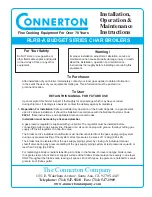
Page 17
Brute
HIGH EFFICIENCY COMMERCIAL BOILERS AND VOLUME WATER HEATERS
Other methods of introducing combustion and ventilation air
are acceptable, providing they conform to the requirements in
the applicable codes listed above.
In Canada, consult local building and safety codes or, in
absence of such requirements, follow CAN/CSA B149.
Ducted Combustion Air
The combustion air can be taken through the wall, or through
the roof. When taken from the wall, it must be taken from
out-of-doors by means of the Bradford White horizontal wall
terminal, kit, See Table 7.
See Table 4 to select the appropriate diameter air pipe.
When taken from the roof, a field-supplied rain cap or an
elbow arrangement must be used to prevent entry of rain
water. (See Figure 18)
Use ABS, PVC, CPVC or galvanized pipe for the combustion
air intake. (See Table 4.) The pipe should be sized per Table
2. Route the intake to the boiler as directly as possible. Seal
all joints. Provide adequate hangers. The unit must not support
the weight of the combustion air intake pipe. Maximum linear
pipe length allowed is shown in Table 4. Subtract 5 allowable
linear ft. (1.5m) for every elbow used.
The connection for the intake air pipe is at the top of the unit.
In addition to air needed for combustion, air shall also be
supplied for ventilation, including air required for comfort
and proper working conditions for personnel. Refer to the
applicable codes.
3.3 Venting
The Brute is a Category IV appliance and may be installed
with PVC and CPVC that complies with ANSI/ASTM D1785
F441, polypropylene that complies with ULC-S636 Class IIb,
or a stainless steel venting system that complies with UL 1738
Standard. (See Table 6)
The unit’s vent can terminate through the roof, or through an
outside wall.
When using PVC/CPVC for vent material, venting must be
connected to the CPVC section included with Brute sizes
80-850. The CPVC vent section included with the Brute may
be broken by CPVC fittings if necessary, but never reduced
in total length. See Table 4 to select the appropriate vent pipe
diameter. When using polypropylene, all vent material must
be produced by the same manufacturer, and have a ULC-S636
rating.
All installations should be done following the vent supplier’s
recommended installation techniques. If manufacturer’s
instructions are not available for the material used, follow the
Bradford White recommendations.
Route vent pipe to the heater as directly as possible. Please see
Table 4 on page 14 for proper diameter vs. length allowed.
NOTE: The vent pipe must pitch upward, toward the vent
terminal, not less than 1/4” per foot, so that condensate
will run back to the Brute and drain out thru the condensate
trap. Horizontal portions of the venting system must be
supported to prevent sagging and may not have any low
sections that could trap condensate. Seal all joints and
provide adequate hangers as required in the venting system
manufacturer’s Installation Instructions. The unit must not
support the weight of the vent pipe.
REMARQUE : Acheminer le tube d’évent à l’appareil de
chauffage le plus directement possible. Veuillez voir le
tableau 4 à la page 13 pour le bon diamètre vs. longueur
autorisée. Le tuyau d’évacuation doit pitch vers le haut, vers
la borne d’évent, pas moins de 1/4 “ par pied, de sorte que les
condensats courir vers l’Brute et écouler thru le réservoir des
condensats. Portions horizontales du système d’aération doit
être soutenu pour empêcher l’affaissement et peut ne pas avoir
de faibles sections qui pourraient piéger des condensats
WARNING
Failure to use polypropylene CPVC or stainless steel
venting for the first 20” (285-600) / 30” (199 / 210)
of vent material or for any part of the venting that is
installed inside a closet may lead to property damage,
personal injury or death. The proper length of this
material is supplied with boiler. Boilers in the U.S. may
use pipe included with the boiler.
Failure to use the appropriate vent material, installation
techniques, glues/sealants could lead to vent failure
causing property damage, personal injury or death.
Use of cellular core PVC (ASTM F891), cellular core
CPVC, or Radel® (polyphenolsulfone) in non-metallic
venting systems is prohibited and that covering non-
metallic vent pipe and fittings with thermal insulation is
prohibited.
All venting must be installed according to this manual
and any other applicable local codes, including but
not limited to, ANSI Z223.1/NFPA 54, CSA B149.1,
CSAB149.2 and ULC-S636. Failure to follow this manual
and applicable codes may lead to property damage,
severe injury, or death.
The flue temperature of the Brute changes dramatically
with changes in operating water temperature. Therefore,
it is necessary to assess the application of the boiler
to determine the required certified vent class. If the
Brute is installed in an application where the ambient
temperature is elevated, and/or installed in a closet/
alcove, polypropylene, CPVC or stainless steel material is
required. If the system temperatures are unknown at the
time of installation, Class IIB or higher venting material is
recommended.
Summary of Contents for Copper Brute II BWCH 2000
Page 4: ...BRADFORD WHITE...
Page 26: ...Page 22 BRADFORD WHITE 150 285 Figure 23 Minimum Venting Distance...
Page 48: ...Page 44 BRADFORD WHITE Figure 38 Ladder Diagram 7 9 Ladder Diagram...
Page 96: ...Page 92 BRADFORD WHITE Parts Illustration 4 Internal Components Sizes 750 850...
Page 98: ...Page 94 BRADFORD WHITE Parts Illustration 6 Gas Train Components Sizes 600 850...
Page 102: ...Page 98 BRADFORD WHITE Notes...
Page 103: ...Page 99 Brute HIGH EFFICIENCY COMMERCIAL BOILERS AND VOLUME WATER HEATERS Notes...
















































